Pergamos, a digital library at the University of Athens, is representative of many interesting resources that have appeared on the Web over the last decade. It contains four collections spanning historical archives, folklore, the theater, and sheet music; and more collections are being developed. The name is an alternate spelling for Pergamum, which, as already mentioned, was the site of a significant library in its day. Here we use Pergamos to exemplify features of a real-world digital library.
The system provides an interface in Greek, English, and French. Figure 1.10a shows the home page (in English), which lists the collections available. For each collection a fitting image is shown, along with a summary of what is provided: a description of the resource, the time span it covers, who owns the material, their contact information, and access rights for the user. Some collections, such as the Historical Archive collection, include subcollections: printed documents and photography from the university archives, the Senate Secretariat, and five of the university’s faculties. These can be accessed individually or collectively.
Suppose a user is interested in finding out which of the seven surviving plays by Sophocles have been performed at the university over the years. He brings up the library’s search page shown in Figure 1.10b and selects the Theatrical collection from a nested list of possibilities. Next he enters sophocles in the search box. The result of the query, shown in Figure 1.10c, is disappointing: only one matching document is found. This is an unexpectedly sparse result for a writer of such prominence, and our user mentally runs a few checks. Was there a typing mistake in the query? Could the uncapitalized initial letter have prevented matching? In both cases the answer is No: the name is correctly spelled, and in this digital library search is case-insensitive. Why then was only one match returned?
It is hard not to notice the size of a physical library. But establishing equivalent cues in the digital realm is tricky. Perhaps, wonders our user, the Theatrical collection is rather small after all? To get a handle on its scope and coverage, he clicks the Navigate button in the interface’s main navigation bar, which appears on each page as a row of words beneath the masthead. A few clicks bring up Figure 1.10d, which lists all items in the collection alphabetically by title. There are 633 items in all, and items 1-20 are presented in summary form: title of the show, thumbnail of the program, table displaying author, director, group, theater, and period. Not all items in the list have all these components. The page also contains navigation links: next page and direct entry to a particular page. The sort order can be changed from ascending to descending, and the sort field can also be chosen.
Clicking through a page or two, our user quickly realizes that author names, titles, and so forth are predominately entered in the Greek alphabet. When the user repeats the search in Greek, Sojoklhv, twelve matches are returned (Figure 1.10e), which accords better with the user’s expectations. He scrolls through the returned matches (Figure 1.10f) and selects the play Avxiyovn (Antigone). Figure 1.10g shows the digitized version of the actual program produced for this show. The thumbnail shown on the left is quick to load, and the main area of the page is taken up with a larger version. A zoom control allows the user to alter the display resolution in order to see different levels of detail. There is a link to the second page (and, where relevant, subsequent pages) of the program. Digital libraries like this can be accessed by anyone, from any corner of the world. This makes it impossible to predict the uses that people will want to make of the material. For instance, research students might study patterns in scribbled annotations left on the paper documents, which would normally be viewed as ephemera, in order to help investigate a hypothesis they have developed. Most visitors are more interested in theatrical aspects.
Figure 1.10: The pergamos Digital Library: (a) home page (in English); (b) searching the theatrical Collection for sophocles;
Figure 1.10, cont’d: (c) search result; (d) browsing titles alphabetically;
Figure 1.10, cont’d: (e) searching for![]() (f) search result;
(f) search result;
Figure 1.10, cont’d: (g) viewing the item![]() (Antigone)
(Antigone)
They might feel that the highest levels of magnification are overkill, but to researchers seeking faded pencil annotations they are a godsend.
Countless digital libraries on the Web adopt the basic form presented in this walk-through. They offer searching and browsing operations to locate items of interest, and ultimately show digital representations of each document, along with ancillary information (metadata). In this example the documents are digitized images (theater programs), to which access is provided through fields of descriptive text, such as title, author, and date. In the case of text-based documents like word-processed reports or Web pages, the full text can be searched as well.




